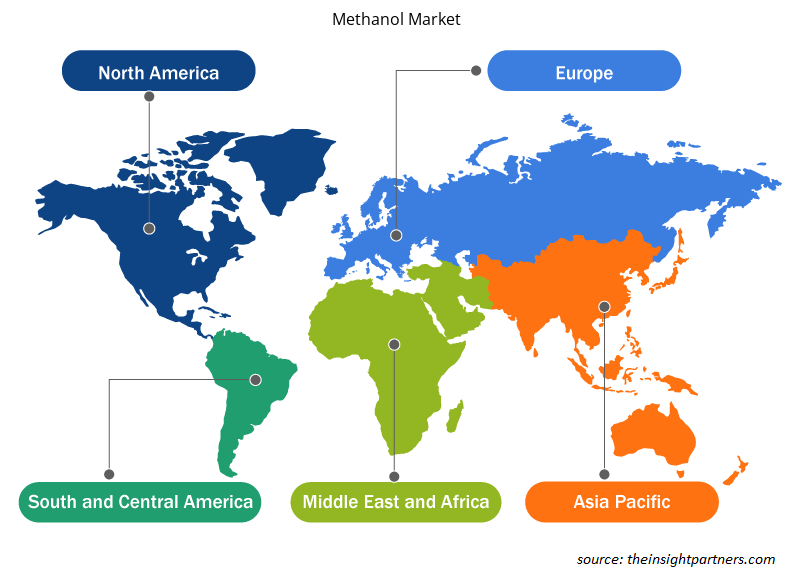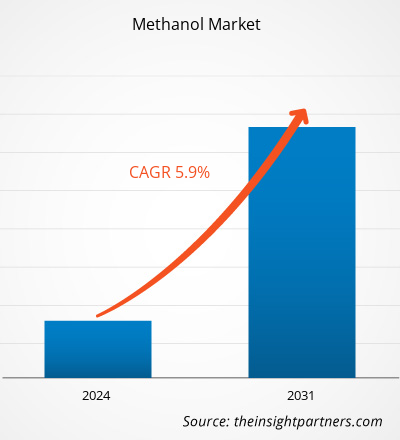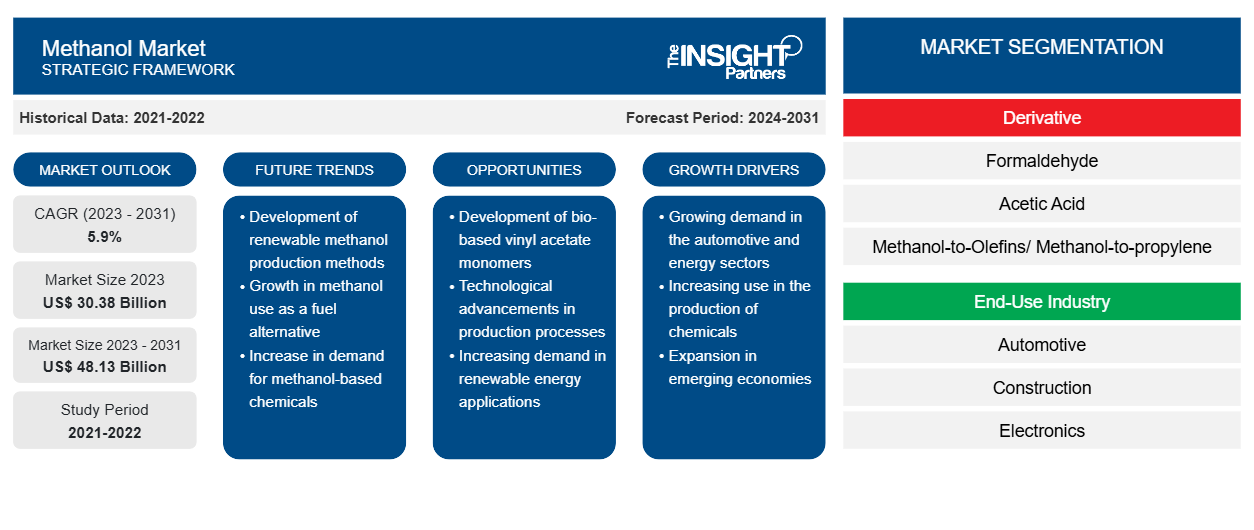Der Methanolmarkt soll von 30,38 Milliarden US-Dollar im Jahr 2023 auf 48,13 Milliarden US-Dollar im Jahr 2031 anwachsen. Der Markt soll zwischen 2023 und 2031 eine durchschnittliche jährliche Wachstumsrate (CAGR) von 5,9 % verzeichnen. Die zunehmende Verwendung von Methanol als Kraftstoffmischung in der Transportbranche dürfte ein wichtiger Trend auf dem Methanolmarkt bleiben.
Methanol-Marktanalyse
Die rasch zunehmenden Bautätigkeiten in verschiedenen Ländern auf der ganzen Welt treiben das Wachstum des Methanolmarktes voran. Die Bauindustrie ist ein Industriezweig mit den besten Aussichten für Mexiko. Die mexikanische Bauindustrie wächst aufgrund des Wirtschaftswachstums und der öffentlichen Investitionen in Infrastrukturprojekte. Mexiko bewegt sich auch schnell in Richtung grüner und umweltfreundlicher Bautätigkeiten. In den letzten Jahren war die Bauindustrie in Indonesien ein Wachstumsmotor. Die rasch urbanisierende Bevölkerung treibt die Nachfrage im Bausektor des Landes an. Darüber hinaus sind das Bevölkerungswachstum und die steigenden staatlichen Ausgaben für die Infrastruktur wichtige Treiber für den Baumarkt in Indonesien.
Methanol-Marktübersicht
Methanol ist die einfachste Alkoholverbindung, die als Zusatzstoff in industriellen Anwendungen verwendet wird. Es ist eine entzündliche, farblose und giftige flüssige Chemikalie mit einem trivialen Geruch. Es wird in verschiedenen Branchen verwendet, beispielsweise in der Automobil-, Bau-, Elektronik-, Verpackungs-, Pharma-, Farben- und Lackindustrie und anderen. Methylalkohol wird zur Herstellung von Formaldehyd, Essigsäure und Methylmethacrylat (MMA) verwendet und kommt auch als Lösungsmittel in verschiedenen Anwendungen zum Einsatz. Methanol und seine durch chemische Reaktionen hergestellten Derivate wie Essigsäure und Formaldehyd werden als Grundstoffe in Acrylatkunststoffen, synthetischen Stoffen und Fasern zur Herstellung von Kleidung, Klebstoffen, Farben und Sperrholz für die Bauindustrie sowie als chemischer Wirkstoff in Pharmazeutika und Agrarchemikalien verwendet.
Passen Sie diesen Bericht Ihren Anforderungen an
Sie erhalten kostenlos individuelle Anpassungen an jedem Bericht, einschließlich Teilen dieses Berichts oder einer Analyse auf Länderebene, eines Excel-Datenpakets sowie tolle Angebote und Rabatte für Start-ups und Universitäten.
-
Holen Sie sich die wichtigsten Markttrends aus diesem Bericht.Dieses KOSTENLOSE Beispiel umfasst eine Datenanalyse von Markttrends bis hin zu Schätzungen und Prognosen.
Treiber und Chancen auf dem Methanolmarkt
Zunehmender Einsatz von Methanol als Rohstoff in verschiedenen Anwendungen
Methanol als wichtiger chemischer Baustein oder als Kraftstoff kann, wenn es aus erneuerbaren Quellen hergestellt wird, dazu beitragen, die Dekarbonisierungsziele zu erreichen. Methylalkohol wird in großem Umfang zur Herstellung von Kunststoffen, Klebstoffen, Isoliermaterialien, Textilien und Lebensmittelchemikalien sowie anderen Chemikalien und Verbindungen verwendet. Die Nachfrage nach Kunststoffen steigt aufgrund des wachsenden Automobilsektors in der Welt. Darüber hinaus werden verschiedene Methylalkoholderivate in großem Umfang in der Pharma- und Gesundheitsbranche verwendet. Daher fördert die zunehmende Verwendung von Methanol in verschiedenen Anwendungen das Wachstum des globalen Methanolmarktes.
Wachsender Fokus auf die Nutzung von grünem Methanol
Grünes Methanol ist Methanol, das erneuerbar und ohne Schadstoffemissionen hergestellt wird. Diese chemische Verbindung wird als kohlenstoffarmer Flüssigbrennstoff verwendet und ist eine vielversprechende Alternative zu fossilen Brennstoffen in Bereichen, in denen die Dekarbonisierung eine große Herausforderung darstellt. In den letzten Jahren haben nachhaltige und kohlenstoffarme Alternativen zu herkömmlichen fossilen Brennstoffen höchste Priorität erlangt. Daher wird erwartet, dass der zunehmende Fokus auf die Verwendung von grünem Methanol lukrativere Möglichkeiten für Marktwachstum bietet.
Segmentierungsanalyse des Methanol-Marktberichts
Wichtige Segmente, die zur Ableitung der Methanol-Marktanalyse beigetragen haben, sind die Derivate- und Endverbrauchsindustrie.
- Basierend auf Derivaten ist der Methanolmarkt in Formaldehyd, Essigsäure, Methanol-zu-Olefine (MTO) / Methanol-zu-Propylen (MTP), Methyl-tert-butylether (MTBE), Methylmethacrylat (MMA), Biodiesel, Dimethylether (DME) und andere unterteilt. Das Formaldehydsegment hielt im Jahr 2023 einen bedeutenden Marktanteil.
- Nach Endverbrauchsbranche ist der Markt in Automobil, Bau, Elektronik, Verpackung, Pharmazeutika, Farben und Lacke und andere unterteilt. Das Automobilsegment hielt im Jahr 2023 einen erheblichen Marktanteil.
Methanol-Marktanteilsanalyse nach Geografie
Der geografische Umfang des Methanol-Marktberichts ist hauptsächlich in fünf Regionen unterteilt: Nordamerika, Asien-Pazifik, Europa, Naher Osten und Afrika sowie Süd- und Mittelamerika.
Der asiatisch-pazifische Raum hält einen größeren Anteil am Weltmarkt. Nordamerika dürfte im Prognosezeitraum eine beträchtliche Wachstumsrate verzeichnen. Methanol wird in großem Umfang zur Herstellung verschiedener Chemikalien und Verbindungen wie Kunststoffen, Klebstoffen, Isoliermaterialien, Textilien und Lebensmittelchemikalien verwendet. Die Nachfrage nach Kunststoffen steigt und begünstigt den Methanolmarkt aufgrund der wachsenden Automobilindustrie in der Region. Die Automobilindustrie verwendet Kunststoffpolymere größtenteils zur Herstellung der Innenstruktur eines Fahrzeugs und anderer Komponenten wie Stoßfänger, Kraftstoffsystem, Radkasten, Türgriffe, Bremsbeläge und Komponenten unter der Motorhaube. Der Einsatz von Kunststoffkomponenten reduziert das Gewicht des Fahrzeugs erheblich, erhöht seine Kraftstoffeffizienz und erfüllt Umweltvorschriften in Bezug auf Kohlenstoffemissionen aus fossilen Brennstoffen.
Regionale Einblicke in den Methanolmarkt
Die regionalen Trends und Faktoren, die den Methanolmarkt im Prognosezeitraum beeinflussen, wurden von den Analysten von Insight Partners ausführlich erläutert. In diesem Abschnitt werden auch Methanolmarktsegmente und -geografie in Nordamerika, Europa, im asiatisch-pazifischen Raum, im Nahen Osten und Afrika sowie in Süd- und Mittelamerika erörtert.

- Erhalten Sie regionale Daten zum Methanol-Markt
Umfang des Methanol-Marktberichts
| Berichtsattribut | Details |
|---|---|
| Marktgröße im Jahr 2023 | 30,38 Milliarden US-Dollar |
| Marktgröße bis 2031 | 48,13 Milliarden US-Dollar |
| Globale CAGR (2023 - 2031) | 5,9 % |
| Historische Daten | 2021-2022 |
| Prognosezeitraum | 2024–2031 |
| Abgedeckte Segmente |
Nach Derivat
|
| Abgedeckte Regionen und Länder |
Nordamerika
|
| Marktführer und wichtige Unternehmensprofile |
|
Dichte der Akteure auf dem Methanol-Markt: Auswirkungen auf die Geschäftsdynamik verstehen
Der Methanolmarkt wächst rasant, angetrieben durch die steigende Endverbrauchernachfrage aufgrund von Faktoren wie sich entwickelnden Verbraucherpräferenzen, technologischen Fortschritten und einem größeren Bewusstsein für die Vorteile des Produkts. Mit steigender Nachfrage erweitern Unternehmen ihr Angebot, entwickeln Innovationen, um die Bedürfnisse der Verbraucher zu erfüllen, und nutzen neue Trends, was das Marktwachstum weiter ankurbelt.
Die Marktteilnehmerdichte bezieht sich auf die Verteilung von Firmen oder Unternehmen, die in einem bestimmten Markt oder einer bestimmten Branche tätig sind. Sie gibt an, wie viele Wettbewerber (Marktteilnehmer) in einem bestimmten Marktraum im Verhältnis zu seiner Größe oder seinem gesamten Marktwert präsent sind.
Die wichtigsten auf dem Methanolmarkt tätigen Unternehmen sind:
- METHANEX CORPORATION
- OCI NV
- BASF SE
- SABIC
- MITSUBISHI GAS CHEMICAL COMPANY, INC.
- HELM AG
Haftungsausschluss : Die oben aufgeführten Unternehmen sind nicht in einer bestimmten Reihenfolge aufgeführt.

- Überblick über die wichtigsten Akteure auf dem Methanolmarkt
Neuigkeiten und aktuelle Entwicklungen zum Methanolmarkt
Der Methanolmarkt wird durch die Erhebung qualitativer und quantitativer Daten aus Primär- und Sekundärforschung bewertet, die wichtige Unternehmensveröffentlichungen, Verbandsdaten und Datenbanken einbeziehen. Im Folgenden finden Sie eine Liste der Entwicklungen auf dem Methanolmarkt und der Strategien:
- Mitsui & Co., Ltd. hat sich bereit erklärt, einen 49-prozentigen Anteil an Kasso MidCo ApS („MidCo“) zu erwerben, einem Tochterunternehmen von European Energy A/S („EE“, einem Unternehmen für erneuerbare Energien mit Sitz in Søborg, Dänemark). MidCo verfügt über ein Geschäft für Solarstromerzeugung und E-Methanol über Solar Park Kasso ApS („Kasso“), seine hundertprozentige Tochtergesellschaft. (Quelle: MITSUI & CO., LTD., Unternehmenswebsite/Pressemitteilungen/2023)
- Jakson Green, ein Akteur im Bereich erneuerbarer und neuer Energien in Indien, gab heute bekannt, dass es ein Projekt der National Thermal Power Corporation (NTPC) gewonnen hat, um im Vindhyachal-Kraftwerk der NTPC in Madhya Pradesh eine Anlage zur Produktion von CO2 zu Methanol zu errichten. (Quelle: PV MAGAZINE, Unternehmenswebsite /2023)
Methanol-Marktbericht – Umfang und Ergebnisse
Der Bericht „Methanol-Marktgröße und -prognose (2021–2031)“ bietet eine detaillierte Analyse des Marktes, die die folgenden Bereiche abdeckt:
- Marktgröße und Prognose auf globaler, regionaler und Länderebene für alle wichtigen Marktsegmente, die im Rahmen des Projekts abgedeckt sind
- Marktdynamik wie Treiber, Beschränkungen und wichtige Chancen
- Wichtige Zukunftstrends
- Detaillierte Porter's Five Forces und SWOT-Analyse
- Globale und regionale Marktanalyse mit wichtigen Markttrends, wichtigen Akteuren, Vorschriften und aktuellen Marktentwicklungen
- Branchenlandschaft und Wettbewerbsanalyse, einschließlich Marktkonzentration, Heatmap-Analyse, prominenten Akteuren und aktuellen Entwicklungen
- Detaillierte Firmenprofile
- Historische Analyse (2 Jahre), Basisjahr, Prognose (7 Jahre) mit CAGR
- PEST- und SWOT-Analyse
- Marktgröße Wert/Volumen – Global, Regional, Land
- Branchen- und Wettbewerbslandschaft
- Excel-Datensatz
Aktuelle Berichte
Erfahrungsberichte
Grund zum Kauf
- Fundierte Entscheidungsfindung
- Marktdynamik verstehen
- Wettbewerbsanalyse
- Kundeneinblicke
- Marktprognosen
- Risikominimierung
- Strategische Planung
- Investitionsbegründung
- Identifizierung neuer Märkte
- Verbesserung von Marketingstrategien
- Steigerung der Betriebseffizienz
- Anpassung an regulatorische Trends























 Kostenlose Probe anfordern für - Methanolmarkt
Kostenlose Probe anfordern für - Methanolmarkt